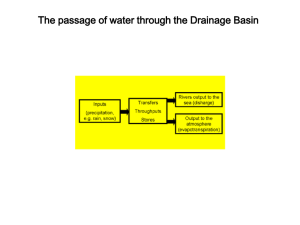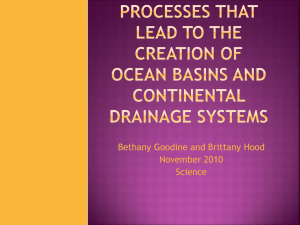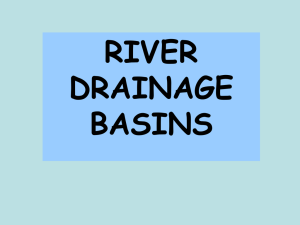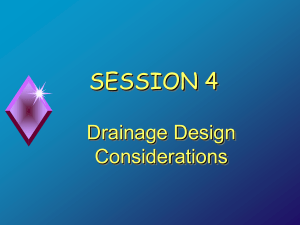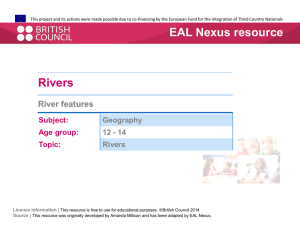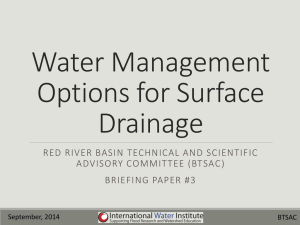lecture-12 Drainage
advertisement
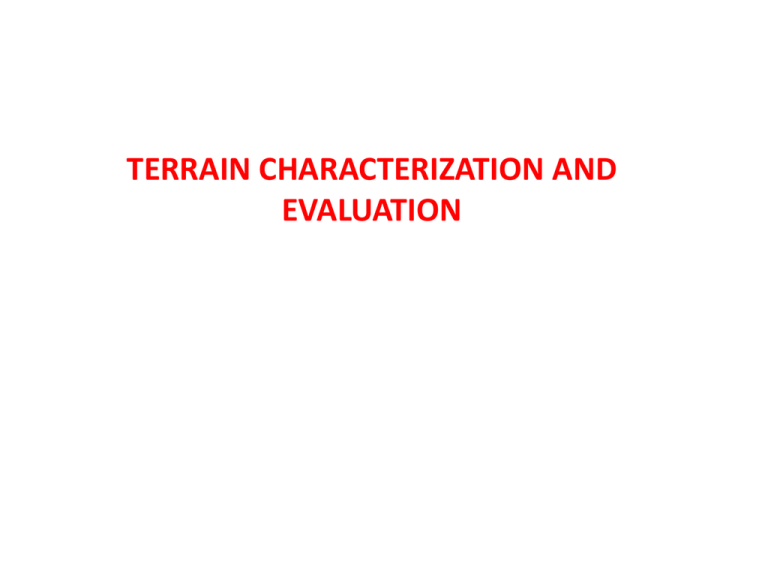
TERRAIN CHARACTERIZATION AND EVALUATION From a utilitarian view point - why do we need to characterize terrains? Direct relation between the terrain type and - nature/competency/strength/structure of the bed rocks - soil type, and - vegetation. Geographers Soil scientists Civil engineers Geologists Urban planners Landscape architects Land-use managers Agriculture scientists, foresters, botanists, ecologists Terrain characteristics that can be studied using remote sensing data: • Landforms and topography • Drainage pattern and texture LANDFORMS AND TOPOGRAPHY • Landform is a geomorphologic unit largely defined by its surface form • Includes seascape and oceanic waterbody interface features such as bays, peninsulas, seas etc • Also include sub-aqueous terrain features such as submersed mountain ranges, volcanoes, and the great ocean basins. Categorised by physical attributes such as elevation, slope, orientation (Topography) JPL, Pasadena TOPOGRAPHY • Elevation of a landform DRAINAGE PATTERN A drainage system is the pattern formed by the streams, rivers, and lakes in a particular drainage basin. Governed by: •Topography of the land •Nature of underlying rocks (compatibility, permeability and porosity), and • Gradient of the land. A drainage basin is the topographic region from which a stream receives runoff, throughflow, and groundwater flow. Drainage basins are divided from each other by topographic barriers called a watershed. A watershed represents all of the stream tributaries that flow to some location along the stream channel. The number, size, and shape of the drainage basins found in an area varies and the larger the topographic map, the more information on the drainage basin is available. Drainage basin = catchment, catchment area, catchment basin, drainage area, river basin, water basin and watershed DRAINAGE PATTERN Drainage pattern 1 1 2 3 4 Drainage basin Watershed Why study drainage? Fundamental input in many applications: - Civil engineering - Agriculture - Hydrology - Disaster management - Geology DRAINAGE PATTERN A dendritic drainage pattern is the most common form and looks like the branching pattern of tree roots. Develops in regions underlain by homogeneous material. That is, the subsurface rocks have similar resistance to weathering so there is no apparent control over the direction the tributaries take. Tributaries joining larger streams at acute angle (less than 90 degrees). DRAINAGE PATTERN Parallel drainage patterns form where there is a pronounced slope to the surface Tributary streams tend to stretch out in a parallel-like fashion following the slope of the surface. DRAINAGE PATTERN Trellis drainage patterns look similar common garden trellis. Trellis drainage develops in folded topography Down-turned folds called synclines form valleys in which resides the main channel of the stream. Short tributary streams enter the main channel at sharp angles as they run down sides of parallel ridges called anticlines. Tributaries join the main stream at nearly right angles DRAINAGE PATTERN Rectangular drainage develops on rocks that are of approximately uniform resistance to erosion, but which have two directions of jointing at approximately right angles. The joints are usually less resistant to erosion than the bulk rock so erosion tends to preferentially open the joints and streams eventually develop along the joints. The result is a stream system in which streams consist mainly of straight line segments with right angle bends, and tributaries join larger streams at right angles. DRAINAGE PATTERN The radial drainage pattern develops around a central elevated point. Commonly found around dome shaped features as volcanoes. The tributary streams extend the head-ward reaches upslope toward the top of the volcano. DRAINAGE PATTERN The centripetal drainage pattern is the reverse of radial drainage pattern, where streams from all directions flow towards a central depression. Common to basin shaped features as volcanic/meteoric craters, sink holes, structural basins. DRAINAGE PATTERN Deranged or contorted patterns develop from the disruption of a pre-existing drainage pattern. DRAINAGE PATTERN DRAINAGE PATTERN DRAINAGE PATTERN DRAINAGE PATTERN DRAINAGE PATTERN DRAINAGE TEXTURE Refers to the relative spacing of streams in a drainage system Drainage density: Total length of the streams in a drainage system/Total area of the drainage system Drainage frequency: Total number of individual streams channels/Total area of the drainage system Coarse-texture – Little surface runoff, good internal drainage, hard permeable rocks such granite; Fine grained – Poor internal drainage, high surface runoff, soft, impermeable and incompetent rocks such as shale.

